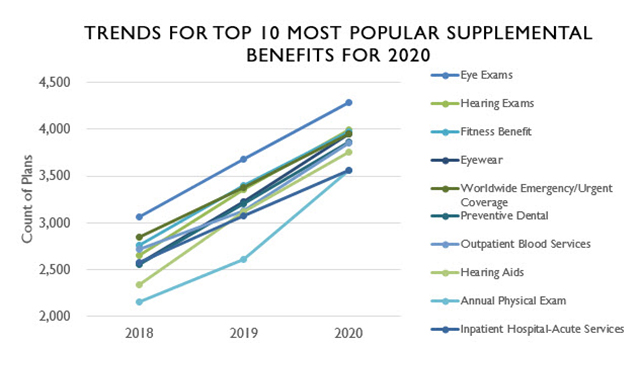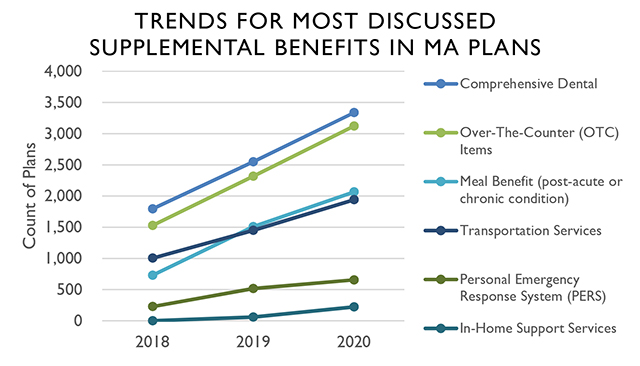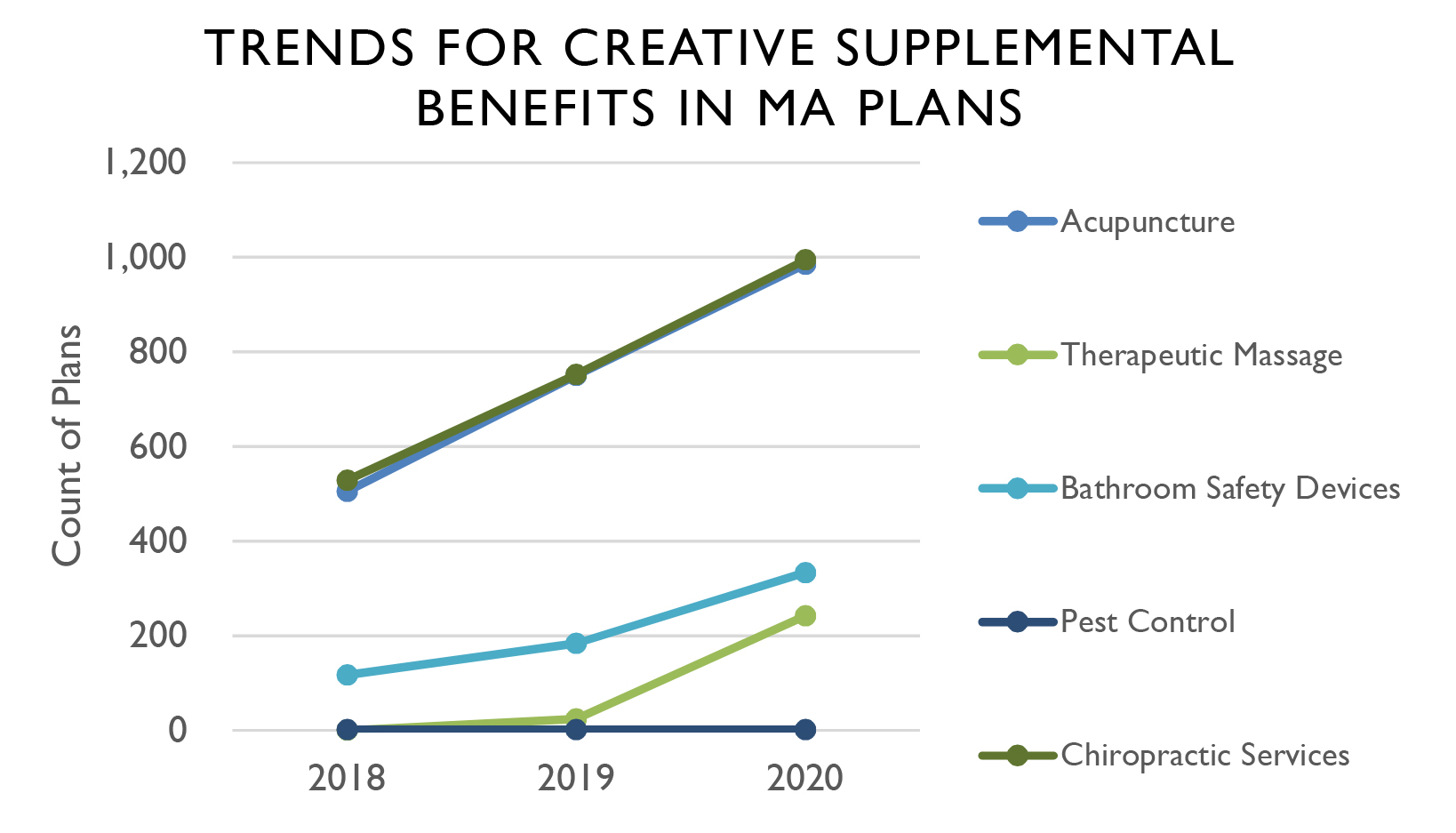Medicare Advantage is the rapidly growing private plan option in the Medicare program. More than 22 million people choose Medicare Advantage (MA) — more than one-third of all Medicare subscribers — and that number is expected to top 30 million in the next few years.
A string of policy changes permitted MA plans, starting in Plan Year 2019, to offer a much wider range of benefits and to tailor their benefits for specific health conditions. (Readers can learn more about the specifics of these policy changes here and here.)
Collectively, these policy changes and the resulting innovations in benefits and services have the potential to move MA from a health insurance program to the nation’s first large-scale population health program. These new offerings also add significant marketing sizzle to Medicare Advantage’s annual campaign to win new members — so further program enrollment growth is a reasonable expectation. Now that marketing for Plan Year 2020 is underway, this is a good time to check on MA supplemental benefits in 2020 and compare them to supplemental benefits in 2018 and 2019.
As shown in Table 1 below, the most popular supplemental continue to be benefits with a long history in the MA program — including optical, audio and dental benefits, and relatively low-cost benefits that plug holes in original Medicare’s idiosyncratic benefit structure. While readers familiar with MA benefits will not be surprised by the benefits on this list, they might be surprised by how many plans do not offer them.
Table 1: Top 10 Most Popular Supplemental Benefits for 2020
| SUPPLEMENTAL BENEFIT CATEGORY | COUNT OF PLANS | PERCENT OF PLANS* |
|---|---|---|
| Eye Exams | 4,291 | 74% |
| Hearing Exams | 3,993 | 69% |
| Fitness Benefit | 3,973 | 68% |
| Eyewear | 3,952 | 68% |
| Worldwide Emergency/Urgent Coverage | 3,949 | 68% |
| Preventive Dental | 3,869 | 67% |
| Outpatient Blood Services | 3,857 | 66% |
| Hearing Aids | 3,757 | 65% |
| Annual Physical Exam | 3,561 | 61% |
| Inpatient Hospital-Acute Services | 3,558 | 61% |
*Out of 5803 plans, excluding MSA, National PACE, and some 1876 Cost plans
Figure 1 (below) shows that, across the board, the frequency with which the most popular supplemental benefits are offered increased substantially in 2019, and again in 2020. When controlled for plan growth of nearly 20% per year, the increase in supplemental benefit frequency ranges from +0.1% (Inpatient Hospital-Acute Services) to +10.2% (Annual Physical Exams) between 2018 and 2020.

In Table 2, we show the variation in the most popular supplemental benefits based on the percent of plans that offer the benefit within plans of the same product type. We note that preferred provider organizations (PPOs) tend to offer these benefits less frequently than health maintenance organizations (HMOs), with PPOs offering them, on average, 60% of the time and HMOs offering them, on average, 70% of the time. (HMOs and PPOs make up about 97% of all MA plans.)
Table 2: Top 10 Most Popular Supplemental Benefits for 2020 by Plan Type
| SUPPLEMENTAL BENEFIT CATEGORY | HMO & HMOPOS | LOCAL & REGIONAL PPO | D-SNP | MMP / HMO | PFFS & 1876 COST |
|---|---|---|---|---|---|
| Eye Exams | 77% | 67% | 88% | 98% | 80% |
| Hearing Exams | 73% | 60% | 86% | 77% | 51% |
| Fitness Benefit | 71% | 64% | 84% | 45% | 59% |
| Eyewear | 73% | 58% | 92% | 98% | 38% |
| Worldwide Emergency/Urgent Coverage | 70% | 63% | 74% | 20% | 87% |
| Preventive Dental | 69% | 64% | 87% | 55% | 49% |
| Outpatient Blood Services | 68% | 62% | 79% | 93% | 83% |
| Hearing Aids | 71% | 52% | 86% | 98% | 42% |
| Annual Physical Exam | 61% | 63% | 58% | 5% | 86% |
| Inpatient Hospital-Acute Services | 61% | 62% | 47% | 93% | 64% |
Over the last two years, we have consulted to numerous MA organizations, associations and vendors about the new supplemental benefit flexibilities — and certain benefits were consistently discussed for their potential to provide positive return on investment (the cost of the benefit is exceeded by costs-avoided by the result of the benefit) or marketing sizzle. In Figure 2, below, we show the rising popularity of the most discussed benefits over the last two years. Readers will note that some of the benefits (Comprehensive Dental and Over-the-Counter Drugs, in particular) are now common MA plan offerings. Transportation and meal benefits are also rapidly growing. Other much talked-about benefits, such as in-home assistance, remain uncommon.

Still, other benefits have been the subject of much discussion for their potential to treat chronic conditions in new ways. These range from covering new provider types such as acupuncturists, therapeutic massage, and chiropractors (beyond existing Medicare-covered chiropractic services) to creative benefits that increase member safety, such as pest control and bathroom/home safety devices. Figure 3 below demonstrates a considerable rise in the number of MA plans covering new providers types, particularly with regard to acupuncture and chiropractic services. There is less uptake on creative new benefits to increase member safety.

To the best of our knowledge, this is the first publicly available paper to show trendlines in MA supplemental benefits — and we think the paper has great value in that context. Yet, it must be acknowledged that there are limitations to this paper, including:
- The Centers for Medicaid and Medicare Services (CMS) benefit data files contain flexible labeling fields that have changed as CMS has attempted to keep pace with all of the innovation it has unleashed. This could create differences in interpretation for certain benefits. For this reason, another researcher looking at the same data might arrive at different numbers for certain benefits.
- The numbers above do not control for enrollment or plan service area. It is possible, for example, that the plans offering meals skew toward lower enrollment or smaller service area plans, thus creating the potential for our chart to overstate the number of Medicare beneficiaries with access to a meals benefit.
- Most importantly, the numbers above do not (yet) include condition-specific benefits (for example, pest control for people with COPD or asthma). CMS will not make this data available until January. When condition specific benefits are made available, we will be pleased to offer further insights in Part II of this report.
If the transformation of Medicare Advantage benefits interests you as much as us, or if you would like to learn more about our MA benefits database and ever-growing bibliography on benefit innovations, contact the authors.
.svg?rev=a492cc1069df46bdab38f8cb66573f1c&hash=2617C9FE8A7B0BD1C43269B5D5ED9AE2)

